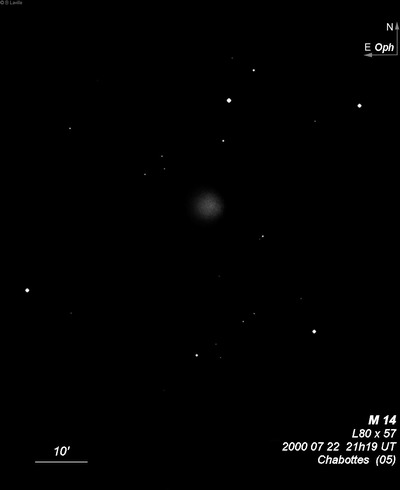
Charles Messier discovered M14 = NGC 6402= h1983 on 1 June 1764 and noted a "Nebula without star, discovered in the garb which dresses the right arm of Ophiuchus, and situated on the parallel of Zeta Serpentis: This nebula is not large, its light is faint, one can see it nevertheless in an ordinary telescope of 3.5-foot [FL]; it is round, near it is a small star of 9th magnitude."
William Herschel, observing with his 12-inch (small 20-foot) on 23 Jul 1783, noted "With a power of 200, I see it consists of stars. They are better visible with 300. With 600, they are too obscure to be distinguished, though the appearance of stars is still preserved. This seems to be one of the most difficult objects to be resolved. With me, there is not a doubt remaining; but another person, in order to form a judgment, ought previously to go through all the several gradations of nebulae which I have resolved into stars." On 25 May 1791 (sweep 1010), he recorded with his 18.7-inch, "eB, R, easily resolvable. With a power of 300 I can see the stars. Resembles the 10th of the Connoiss. which probably would put on the same appearance as this, if it were off half as far again as it is."
On 30 May 1821, his second night of being instructed how to sweep and record objects, 29-year old John Herschel logged M14 as "a globular cluster of excessively small stars, barely but certainly resolved with the examining power and difficult with the sweeping power, brighter in the middle." The sweep was registered out of order in his Slough Catalogue as sweep 54.
300/350mm - 13" (7/5/83): fairly large, broad concentration. About a dozen very faint stars are resolved across the disk. The outer halo fades out smoothly.
400/500mm - 17.5" (7/1/00): this bright, large, fairly symmetric globular appears elongated ~E-W and ~7'x5' in size at 220x. The bright core is relatively large at 4', very lively and granular with a layer of very faint stars. At 280x, ~30 stars are resolved in the small halo and at the edge of the intense core. A rich, even sprinkling of faint stars cover the core. It was difficult to count the resolved stars as numerous dim stars pop out with averted vision over the bright background haze, but perhaps 60-70 stars in total were glimpsed.
17.5" (7/16/88): bright, large, 25-30 very faint stars are resolved mostly at the edges which have a ragged appearance.
600/800mm - 24" (7/30/16): at 432x; very bright, large, nearly fills the 10' field. The outer halo is resolved into dozens of star, perhaps 50 or 60 total. The relatively large core is plastered with tiny resolved stars; roughly 50 additional stars were resolved over a lively background, so overall at least a 100 total though difficult to count due to density and the bright background glow. The outer halo is slightly elongated E-W as well as the core, but the overall appearance is symmetrical. The core only exhibits a broad, weak concentration.
Notes by Steve Gottlieb